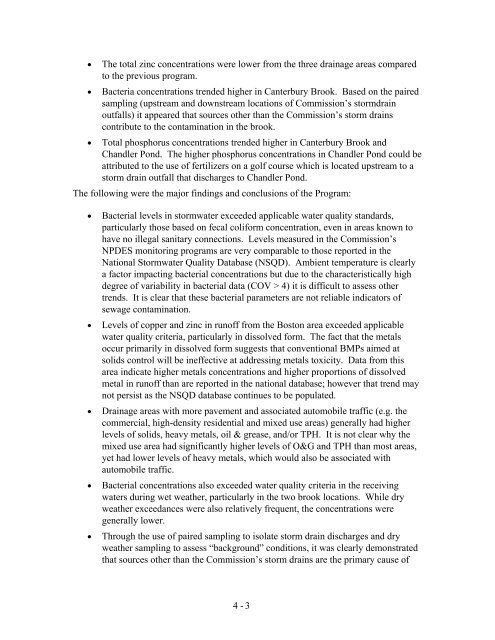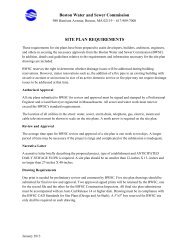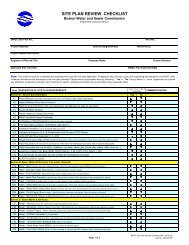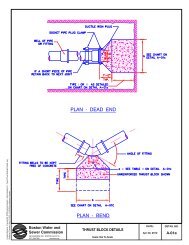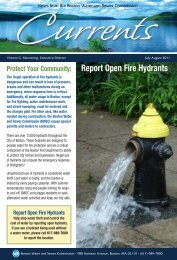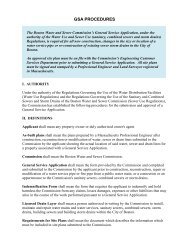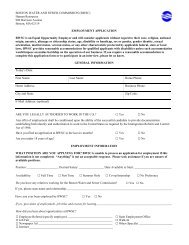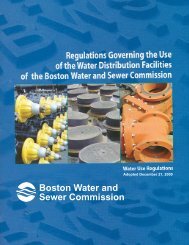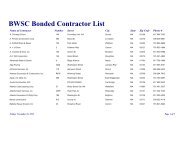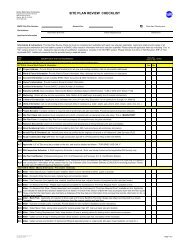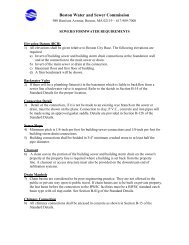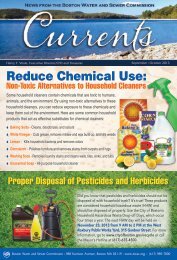2011 Stormwater Annual Report - Boston Water and Sewer ...
2011 Stormwater Annual Report - Boston Water and Sewer ...
2011 Stormwater Annual Report - Boston Water and Sewer ...
- No tags were found...
Create successful ePaper yourself
Turn your PDF publications into a flip-book with our unique Google optimized e-Paper software.
• The total zinc concentrations were lower from the three drainage areas comparedto the previous program.• Bacteria concentrations trended higher in Canterbury Brook. Based on the pairedsampling (upstream <strong>and</strong> downstream locations of Commission’s stormdrainoutfalls) it appeared that sources other than the Commission’s storm drainscontribute to the contamination in the brook.• Total phosphorus concentrations trended higher in Canterbury Brook <strong>and</strong>Ch<strong>and</strong>ler Pond. The higher phosphorus concentrations in Ch<strong>and</strong>ler Pond could beattributed to the use of fertilizers on a golf course which is located upstream to astorm drain outfall that discharges to Ch<strong>and</strong>ler Pond.The following were the major findings <strong>and</strong> conclusions of the Program:• Bacterial levels in stormwater exceeded applicable water quality st<strong>and</strong>ards,particularly those based on fecal coliform concentration, even in areas known tohave no illegal sanitary connections. Levels measured in the Commission’sNPDES monitoring programs are very comparable to those reported in theNational <strong>Stormwater</strong> Quality Database (NSQD). Ambient temperature is clearlya factor impacting bacterial concentrations but due to the characteristically highdegree of variability in bacterial data (COV > 4) it is difficult to assess othertrends. It is clear that these bacterial parameters are not reliable indicators ofsewage contamination.• Levels of copper <strong>and</strong> zinc in runoff from the <strong>Boston</strong> area exceeded applicablewater quality criteria, particularly in dissolved form. The fact that the metalsoccur primarily in dissolved form suggests that conventional BMPs aimed atsolids control will be ineffective at addressing metals toxicity. Data from thisarea indicate higher metals concentrations <strong>and</strong> higher proportions of dissolvedmetal in runoff than are reported in the national database; however that trend maynot persist as the NSQD database continues to be populated.• Drainage areas with more pavement <strong>and</strong> associated automobile traffic (e.g. thecommercial, high-density residential <strong>and</strong> mixed use areas) generally had higherlevels of solids, heavy metals, oil & grease, <strong>and</strong>/or TPH. It is not clear why themixed use area had significantly higher levels of O&G <strong>and</strong> TPH than most areas,yet had lower levels of heavy metals, which would also be associated withautomobile traffic.• Bacterial concentrations also exceeded water quality criteria in the receivingwaters during wet weather, particularly in the two brook locations. While dryweather exceedances were also relatively frequent, the concentrations weregenerally lower.• Through the use of paired sampling to isolate storm drain discharges <strong>and</strong> dryweather sampling to assess “background” conditions, it was clearly demonstratedthat sources other than the Commission’s storm drains are the primary cause of4 - 3


